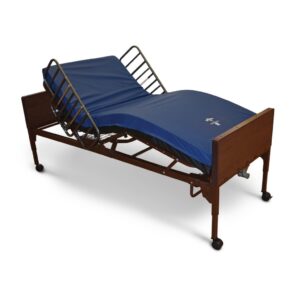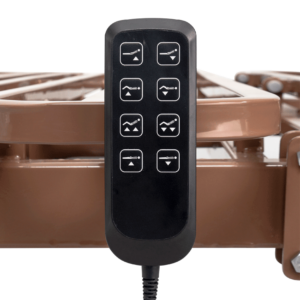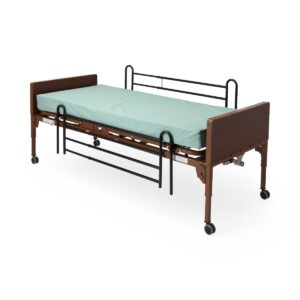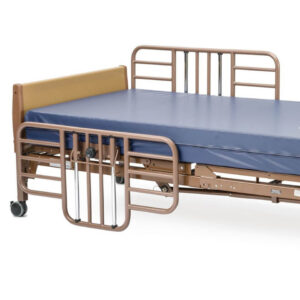
A hospital bed is more than just a place to sleep – it’s a crucial piece of medical equipment that can significantly impact patient comfort, safety, and independence.
This guide will help you understand the various types of beds and options available to make an informed decision about your hospital bed selection.
Core Features to Consider
Basic Bed Functions
- Head Adjustment: All medical beds can raise the head section.
- Foot Adjustment: All medical beds can elevation of legs and feet
- Bed Height: SOME medical beds raise and lower the entire bed frame. This can be accomplished by a manual hand crank at the foot of the bed, or electronically by pressing a button on the remote. The adjustable bed height is generally NOT covered by insurance. However, this option may be added for an additional fee in certain circumstances.
Control Types

A. Semi-Electric:
- Electric controls for head and foot sections
- Manual crank for bed height
- Most commonly covered by insurance
B. Full Electric:
- Electric controls for all functions
- Available as an upgrade (additional cost)
- Recommended for patients with limited mobility or caregiver support
C. Manual:
- Manual hand cranks are used at the head and foot of the bed to adjust each section. These are rarely used today but may be practical in very limited circumstances
Available Configurations
Bed Rails
A. Full-Length Rails:

- Maximum fall protection
- Assists with repositioning
- Can be lowered for transfers
B. Half Rails:

- Provides positioning support
- Allows easier access for transfers
- Less institutional appearance
Frame Options
-
Standard Frame:
These bed frames are suitable for most home situations. They can support 250 pounds and accommodate a person up to six (6) feet tall.
- High/Low Frame:
- Extra low position for fall risk patients
- Recommended for confused or agitated patients
- Same weight and height capacities as the standard frame
- Heavy Duty Frame: Available for bariatric patients
- HD weight capacity from 251-400 pounds
- xHD weight capacity from 401-600 pounds
- Bed Extension: Available for patients over 6' tall
Casters
- Standard: Basic mobility for cleaning
- Locking: Additional stability
- Premium: Enhanced mobility for frequent room changes
Mattress Selection
Standard Options
1. Innerspring
- Most common option
- Durable and comfortable
- Covered by most insurance plans
- Vinyl exterior over foam with innersprings (similar to regular mattresses)
2. Foam
- Pressure relief
- Good wound prevention
- May be covered by insurance with additional documentation
3. Group 1 Support Surface:
- Enhanced pressure relief
- For patients at risk of skin breakdown
- Requires specific documentation
4. Low Air Loss (Group 2 Support Surface):
- Active pressure management
- Temperature regulation
- Requires separate qualification
Specialty Bed Options
Acute Care Beds
Acute care beds are what you generally see in the hospital. There are many variations of these beds and they range in price from $5,000-$80,000 depending on their functions.
These beds can way several hundred pounds and are rarely used in the home.
- Hospital-grade equipment
- Full electric controls
- Advanced positioning options
- Not typically covered by insurance
- Best for:
- High acuity patients
- Long-term home care
- Complex medical needs
Long Term Care Beds
Long term care beds are generally used in skilled nursing facilities. These beds have many of the same functions as acute care beds. They provide easy access and positioning for caretakers. These beds are fully electric and usually offer additional positioning options.
These beds are not used in the home often due to their expense and weight. However, there are circumstances where this type of bed may be appropriate.
- Enhanced durability
- Designed for extended use
- Superior caregiver access
- Home assessment required due to weight and size of bed
- Not typically covered by insurance
- Ideal for:
- Semi-ambulatory patients
- Post-stroke care
- Extended rehabilitation
Essential Accessories
Patient Support
- Trapeze Bars:
- Assists with repositioning
- Promotes independence
- May be covered separately
Bedding Solutions
- Specialized Sheets:
- Fitted for hospital bed dimensions
- Extra-long options available
- Consider multiple sets
Protection
- Mattress Covers:
- Waterproof options
- Antimicrobial protection
- Easy cleaning
- Long-term Mattress Pads:
- Incontinence protection
- Extends mattress life
- Washable options
Insurance Considerations
Standard Coverage
- Semi-electric bed is typically covered when medical necessity is documented
- Basic rails usually included
- Standard innerspring mattress included
Common Upgrades (Additional Cost)
- Full electric controls
- Specialty frames
- Advanced mattress systems
- Premium accessories
Documentation Requirements
- Physician prescription
- Medical necessity documentation
- Specific requirements for additional features
- Regular renewal of documentation may be needed
Making Your Decision
Key Questions to Ask
- How long will the bed be needed?
- Who will operate the bed controls?
- What is the home layout and available space?
- Are there specific medical conditions requiring special features?
- What is the budget for items not covered by insurance?
Delivery and Setup Considerations
- Measure doorways and hallways
- Plan the bed location
- Consider power outlet locations
- Ensure adequate space for caregiver access
Long-term Planning
- Consider future medical needs
- Plan for potential condition changes
- Think about maintenance requirements
- Factor in replacement parts and accessories
